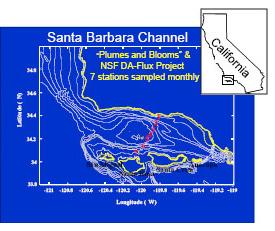Toxigenic Bloom Predictive Model, Santa Barbara Channel: Background
Model Specifics
The documented link between upwelling-related physical signatures, macronutrients, and toxigenic Pseudo-nitzschia blooms in the various “hotspots” throughout California has motivated attempts to forecast these harmful algal blooms (HABs) as a function of select environmental variables. The Santa Barbara Channel (SBC), CA is one such localized region for toxic diatom blooms in the California Current System, with nearly annual toxic events occurring in spring and summer months since 2002.
Existing statistical models that use physical, chemical, and bio-optical observations for predicting Pseudo-nitzschia abundance and domoic acid (DA) concentration in the SBC are currently being tested in a nowcast mode using spatially-explicit predictions of environmental variables from MODIS ocean color geophysical data and a Regional Ocean Modeling System (ROMS) model for the SBC. Relevant thresholds for each model generate “event” forecasts, and results are validated relative to on-going monthly observations along a channel-wide transect to assess the potential use of model predictions by resource managers.
Mesoscale physical processes such as seasonally-occurring eddies that may retain blooms within the SBC are often emergent features in model runs, and these features are compared to high-frequency radar (CODAR) images of daily surface currents. Additional comparisons of model output with domoic acid levels in commercial mussels collected by the CA Department of Public Health demonstrate the disconnect in the relationship between in situ bloom dynamics and the toxin loads measured in nearshore shellfish beds.
Source: Anderson, CR, Ocean Sciences 2010

The red dots on this map indicate Plumes and Blooms sampling stations. Samples were collected monthly between November 2004 and June 2006, and again in 2009-2011, which measured Pseudo-nitzschia abundance as well as particulate and cellular domoic acid levels. These data, which include several large toxic bloom events, were used to test the accuracy of statistical models that incorporate satellite ocean color and sea surface temperature data. For model specifics, click here.

